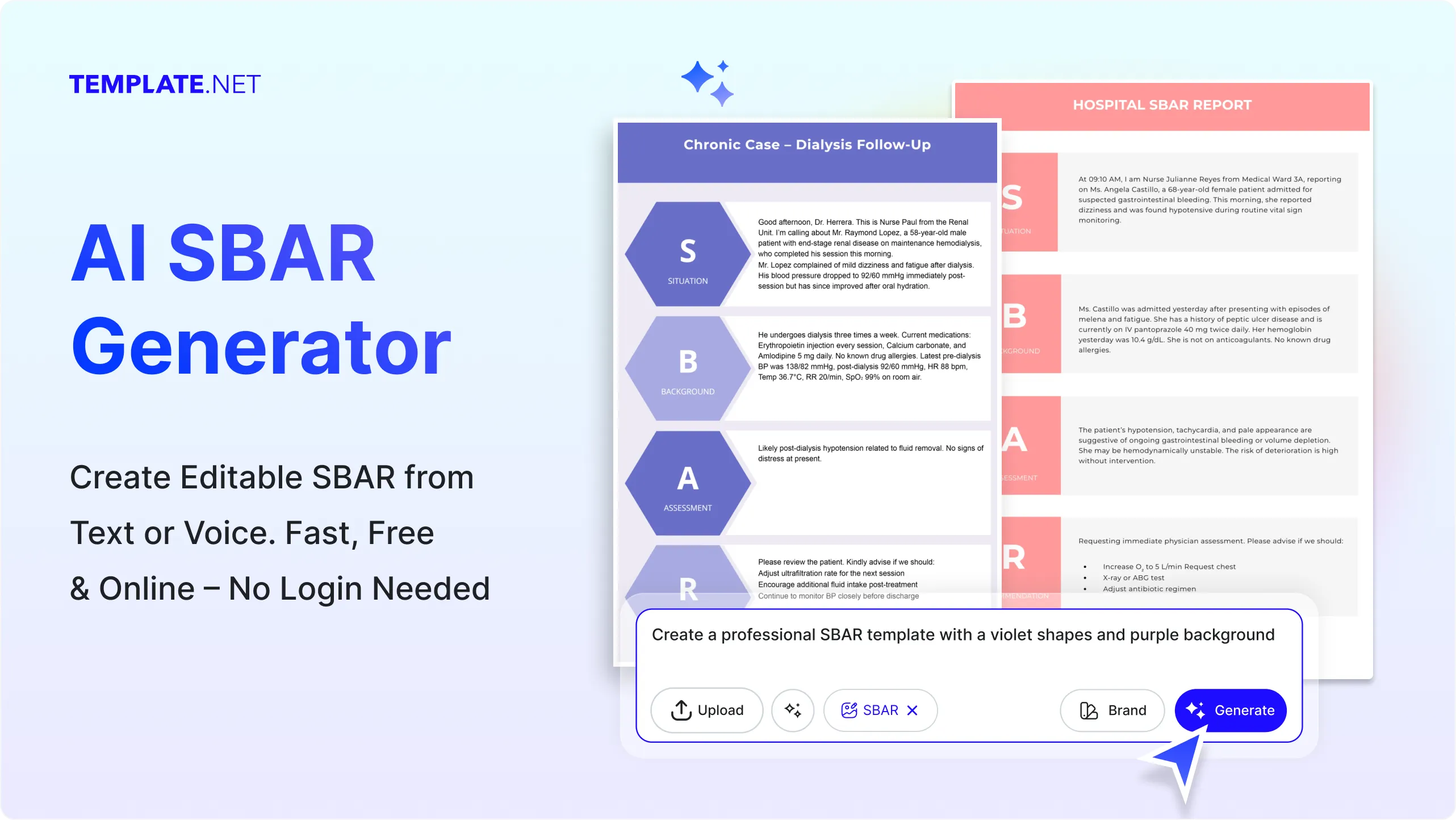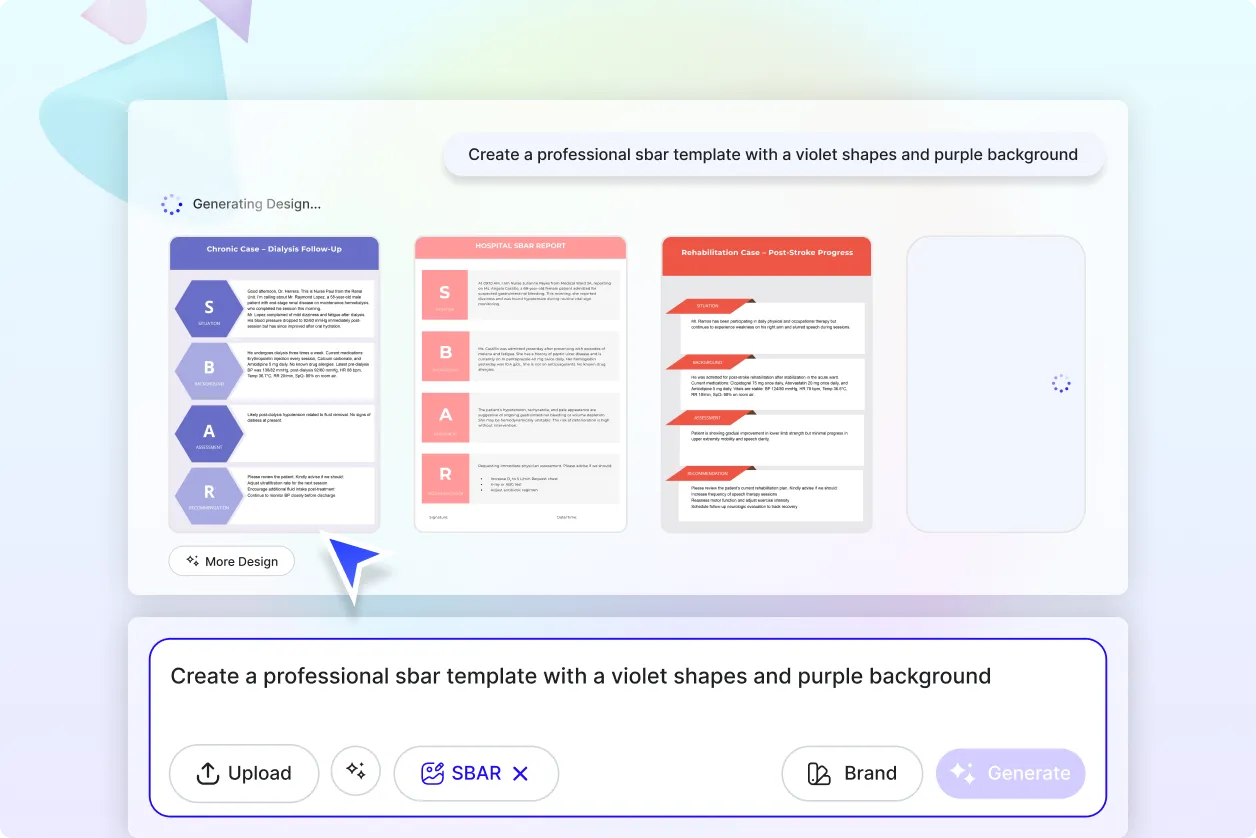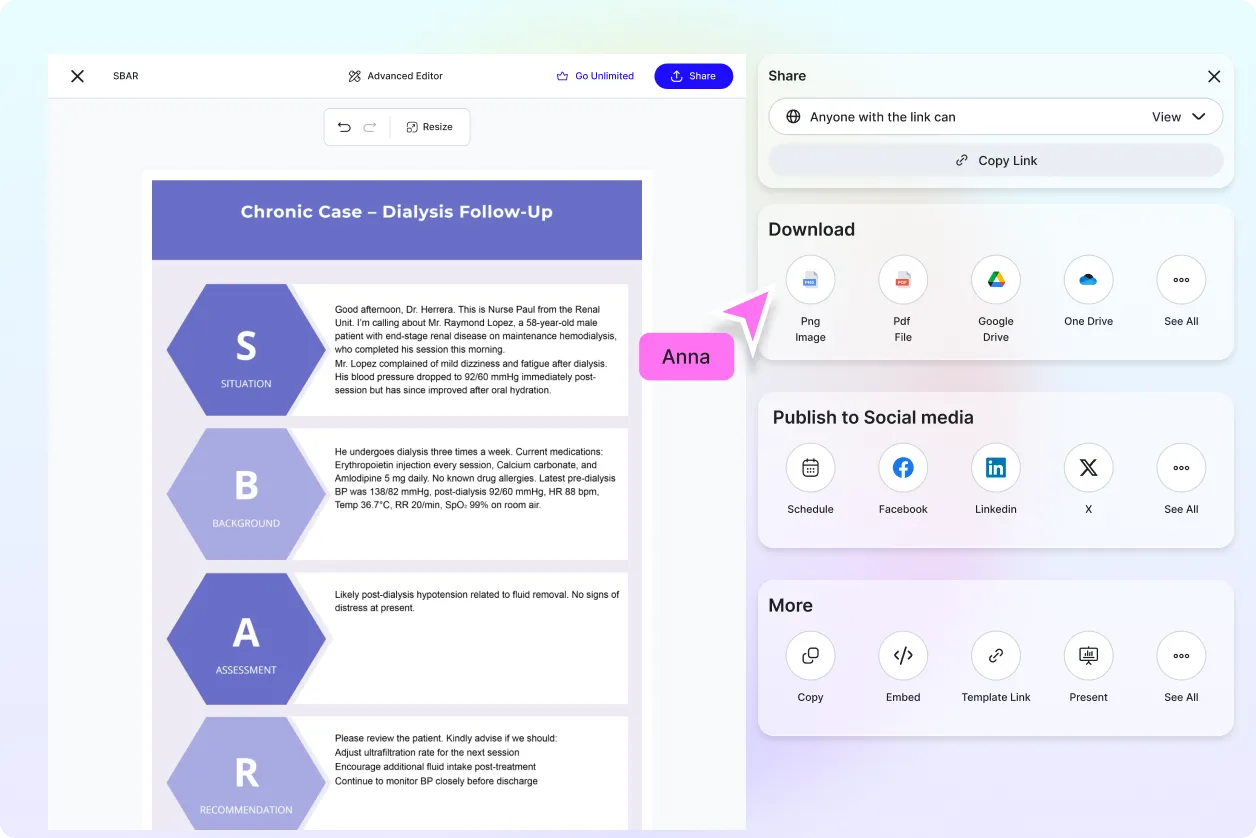Free AI SBAR Generator
Prompt text or voice, our AI generates editable, professional free SBAR reports instantly. Summarize situation, background, assessment, and recommendations with clear, structured communication. No sign-up needed, fast, and online.
Design Professional Clinical SBAR Reports Online
Template.net’s Free AI SBAR Generator helps nurses, clinicians, and medical teams create clear, standardized communication tools. Generate, edit, and export SBAR reports instantly for handoffs, consultations, and patient care documentation.

Create Accurate, Compliant SBAR Reports Effortlessly
Generate structured SBAR summaries in minutes. Customize fields for Situation, Background, Assessment, and Recommendation to ensure clear, consistent, and safe clinical communication across teams and departments.
AI-Powered SBAR Formatting
Automatically generate structured SBAR reports using AI. Input key clinical data, and the system creates professionally formatted Situation-Background-Assessment-Recommendation sections for accurate, standardized handoffs.
Editable SBAR Templates
Access ready-made, editable SBAR templates for various specialties ICU, ER, surgical, and outpatient care. Modify fields and tone to fit your institution’s documentation standards.
Drag-and-Drop Report Builder
Easily add patient information, clinical data, and recommendations using a drag-and-drop editor. Instantly preview the final SBAR layout for accuracy and clarity before exporting.
Multiple SBAR Format Modes
Choose from AI auto-generation, manual entry, or custom layout modes. Generate nursing, medical, or administrative SBARs based on the context of care.
Advanced Customization Tools
Refine SBAR design with editable text fields, custom headers, and professional terminology. Add clinical codes or key phrases for enhanced clarity and compliance.
Upload Patient or Clinical Data
Import patient summaries or EHR data securely. The AI automatically populates appropriate SBAR sections for quick review and documentation.
Clinical Phrase and Term Library
Access a built-in library of common clinical phrases, diagnoses, and recommendation templates. Select precise terminology to enhance accuracy and readability in reports.
Dynamic Formatting and Layout
Customize column widths, fonts, and spacing for optimized print or digital presentation. Ensure legible, organized SBAR formats that align with hospital documentation standards.
Multilingual Text Support
Generate SBARs in multiple languages for international medical teams. AI automatically adjusts terminology and layout for readability and professional translation.
High-Quality Print & Digital Output
Export SBARs in print-ready or digital formats for record keeping. Maintain clear section separation and accurate alignment for charting or electronic submission.
Cloud Integration for SBAR Projects
Save and organize your SBAR reports in cloud storage platforms like Google Drive or OneDrive. Access them anywhere for team collaboration and secure archiving.
Real-Time Collaboration
Collaborate with nursing staff, physicians, or clinical educators in real time. Review, comment, and approve SBAR reports before final handoff.
Export in Multiple Formats
Download completed SBARs in PDF, DOCX, or TXT formats. Each option preserves content integrity and layout for easy distribution and EHR integration.
Instant Sharing Across Platforms
Share AI-generated SBAR reports via email, LMS, or secure messaging systems. Facilitate instant handoffs and communication between care teams.
Save Custom SBAR Presets
Create and save custom SBAR formats for specific units or specialties. Reuse templates to ensure consistency across departments and reduce documentation time.
Cross-Device Editing Access
Design and edit SBAR reports across desktop, tablet, or mobile devices. Access your AI tool anytime for on-the-go clinical documentation.
Organized SBAR Project Folders
Categorize SBAR files by patient, shift, or department. Keep communication records structured for audits and continuous improvement reviews.
Autosave & Version History
Every edit is automatically saved. Review previous SBAR versions to track changes, compare entries, and maintain transparent record keeping in healthcare settings.

How to Generate an SBAR Report with AI SBAR Generator
Create a professional SBAR in three simple steps no training needed.
Step 1: Input Patient Details & Choose Template
Enter patient information and select the SBAR type (nursing, clinical, administrative). AI suggests a structured format based on your context.
Step 2: Customize Sections & Add Data
Modify Situation, Background, Assessment, and Recommendation fields. Add clinical notes or recommendations for clarity and decision support.
Step 3: Download, Share, or Print
Export your final SBAR as PDF or DOCX, share instantly with teams or print for handoff documentation.
Create SBAR Reports in Seconds and Share Instants

Generate Reports with Precision
Use AI-driven templates to build accurate SBAR communication tools. Automatically structure information for clear, safe handoffs and team coordination.

Customize Every SBAR
Edit terminology, section order, and scoring notes to reflect your organization’s standards and clinical protocols.

Share Anywhere, Collaborate Instantly
Distribute SBARs to teams through email or secure messaging. Enable real-time collaboration and rapid feedback on patient updates.

Smart SBAR Workspaces
Organize SBAR reports by unit, shift, or case type. Ensure quick retrieval for audits or performance evaluations.
SBAR Generator FAQ
What is an AI SBAR Generator?
It’s an AI-powered tool that automatically creates standardized Situation-Background-Assessment-Recommendation reports for healthcare handoffs and clinical communication.
How do I create an SBAR using AI?
Enter key patient data and select a template. The AI formats and structures your SBAR instantly for accurate, professional communication.
Can I customize SBAR templates?
Yes. You can edit section titles, add clinical notes, and adjust the tone for nursing or medical documentation.
What file formats can I download?
Download your SBAR in PDF, DOCX, or TXT formats for printing or secure digital sharing.
Can I generate different types of SBAR reports?
Absolutely. Create nursing, emergency, training, or administrative SBARs each with customizable structure and tone.
Is the AI SBAR Generator free to use?
Yes. Basic SBAR generation is free. Premium plans offer advanced editing, bulk generation, and cloud storage features.
Can I collaborate with others while designing SBARs?
Yes. Invite colleagues to edit and review SBARs in real time for accurate, team-approved clinical communication.